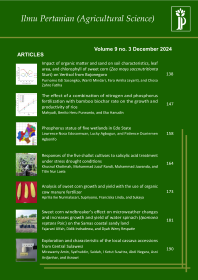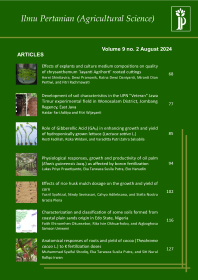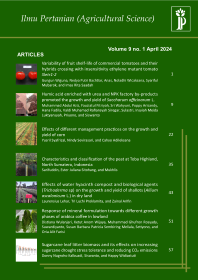
Effects of different soil management styles and cropping practices on the yield and quality of fava bean (Vicia faba L.)
Somayeh Karami(1*)
(1) Faculty of Agricultural Sciences and Natural Resources, University of Khuzestan, Mollasani, Khuzestan, Iran
(*) Corresponding Author
Abstract
This research aimed to determine the effects of various soil tillage techniques and the use of organic and chemical fertilizers on the overall yield and quality of fava beans. The study emphasized the significance of fertilizer types and their interaction with soil tillage methods. Although the quantity of grains per pod was notably influenced by the choice of fertilizers, the impact of soil tillage alone was found to be insignificant. Moreover, this study demonstrated that the yield index of fava beans was significantly influenced by fertilizer sources, emphasizing the importance of proper nitrogen managements. These findings provide valuable insights for enhancing crop production and quality through optimized soil tillage practices and the use of organic and chemical fertilizers. Through an examination of both the measurable and qualitative elements of fava bean cultivation, this study offers valuable knowledge on how to optimize the application of nitrogen fertilizers and effectively utilize mycorrhizal inoculation to improve grain yield and seed quality. These findings have implications for sustainable agriculture practices and guide farmers and researchers in making informed decisions regarding soil management strategies in fava bean cultivation.
Keywords
Full Text:
PDFReferences
Alvarez, R. and Steinbach, H.S. (2009) A Review of the Effects of Tillage Systems on Some Soil Physical Properties, Water Content, Nitrate Availability and Crops Yield in the Argentine Pampas. Soil & Tillage Research, 104, 1–15.
Ardakani, M.R., Majd, F., and Noormohammadi, G. (2006). Evaluating the efficiency of mycorrhiza and esterpetomysis in phosphorous different levels and effect of their utiliz on wheat yield. Iranian Journal of Agronomy Sciences, 2(2), pp. 17–27. (In Persian)
Collins D.P. and Jacobsen, B.J. (2003). Optimizing a Bacillus subtilis isolate for biological control of sugar beet Cercospora leaf spot. Biol. Contr., 26(2), pp. 153–161.
Dotaniya, M.L., Meena, V.D., Basak, B.B. and Meena, R.S. (2016) Potassium Uptake by Crops as Well as Microorganisms. In: Meena, V.S., Maurya, B.R., Prakash Verma, J. and Meena, R.S., eds., Potassium Solubilizing Microorganisms for Sustainable Agriculture. New Delhi: Springer, pp. 267–280.
Egamberdieva, D., Wirth, S., Behrendt, U., Abd_Allah, E.F., and Berg, G. (2016). Biochar Treatment Resulted in a Combined Effect on Soybean Growth Promotion and a Shift in Plant Growth Promoting Rhizobacteria. Front. Microbiol., 7, pp. 209.
Fan, R., Huang, Y. C., Grusak, M. A., Huang, C. P., and Sherrier, D. J. (2013). Effects of nano-TiO2 on the agronomically-relevant Rhizobium–legume symbiosis. Science of the Total Environment, 466, 503-512.
Girolami, V., Mazzon, L., Squartini, A., Mori, N., Marzaro, M., Di Bernardo, A., and Tapparo, A. (2009). Translocation of neonicotinoid insecticides from coated seeds to seedling guttation drops: a novel way of intoxication for bees. J. Econ. Entomol., 102(5), pp. 1808–1815.
Großkinsky, D.K., Tafner, R., Moreno, M.V., Stenglein, S.A., De Salamone, I.E.G., Nelson, L.M., Roitsch, T. (2016). Cytokinin production by Pseudomonas fluorescens G20–18 determines biocontrol activity against Pseudomonas syringae in Arabidopsis. Sci. Rep., 6, pp. 23310.
Grover, M., Ali, S.Z., Sandhya, V., Rasul, A., Venkateswarlu, B. (2011). Role of microorganisms in adaptation of agriculture crops to abiotic stresses. World J. Microbiol. Biotechnol., 27(5), pp. 1231–1240.
Jackson, M.C. (1964). Soil chemical analysis. Constable and Co. Ltd. London. pp. 183–192.
Khan, R.A.A., Tang, Y., Naz, I., Alam, S.S., Wang, W., Ahmad, M., Najeeb, S., Rao, C., Li, Y., and Xie, B. (2021). Management of Ralstonia solanacearum in Tomato Using ZnO Nanoparticles Synthesized through Matricaria chamomilla. Plant Dis, 105, pp. 3224–3230.
Kumar, K.V.K., Yellareddygari, S.K., Reddy, M., Kloepper, J., Lawrence, K., Zhou, X., Sudini, H., Groth, D.E., Raju, S.K., and Miller, M.E. (2012). Efficacy of Bacillus subtilis MBI 600 against sheath blight caused by Rhizoctonia solani and on growth and yield of rice. Rice Sci., 19(1), pp. 55–63.
Lian, L., Xie, L., Zheng, L., and Lin, Q. (2011). Induction of systemic resistance in tobacco against Tobacco mosaic virus by Bacillus spp. Biocontrol Sci. Technol., 21(3), pp. 281–292.
Meena, K.R. and Kanwar, S.S. (2015). Lipopeptides as the antifungal and antibacterial agents: applications in food safety and therapeutics. Biomed. Res. Int., 2015, 473050.
Mirbakhsh, M. (2023). Role of Nano-fertilizer in Plants Nutrient Use Efficiency (NUE). J Gene Engg Bio Res, 5(1), pp. 75–81.
Mirbakhsh, M. and Sedeh, S.S.S. (2022). Effect of short and long period of salinity stress on physiological responses and biochemical markers of Aloe vera L. Ilmu Pertanian (Agricultural Science), 7(3), pp. 178–187.
Mirbakhsh, M., Zahed, Z., Mashayekhi, S., and Jafari, M. (2023). Investigation of in vitro apocarotenoid expression in perianth of saffron (Crocus sativus L.) under different soil EC. Journal of Applied Agricultural Sciences, 7(1), pp. 16–24.
Mishra, J., Singh, R., and Arora, N.K. (2017). Plant growth-promoting microbes: diverse roles in agriculture and environmental sustainability. In: Kumar V., Kumar M., Sharma S., Prasad R., editors. Probiotics and Plant Health, 2017, pp. 71–111
Modolo, L.V., da-Silva, C.J., Branda˜o, D.S., and Chaves, I.S. (2018). A minireview on what we have learned about urease inhibitors of agricultural interest since mid-2000s. J. Adv. Res., 13, pp. 29–37.
Moreau, M., Azzopardi, M., Cle´ment, G., Dobrenel, T., Marchive, C., Renne, C., MartinMagniette, M.L., Taconnat, L., Renou, J.P., and Robaglia, C. (2012). Mutations in the Arabidopsis homolog of LST8/GbL, a partner of the target of rapamycin kinase, impair plant growth, flowering, and metabolic adaptation to long days. Plant Cell, 24, pp. 463–481.
Muñoz-Romero, V., Lopez-Bellido, L., and Lopez-Bellido, R.J. (2015). Effect of tillage system on soil temperature in a rainfed Mediterranean Vertisol. International Agrophysics, 29(4), pp. 467–473.
Mutegi, J.K., Munkholm, L.J., Petersen, B.M., Hansen, E.M., and Petersen, S.O. (2010). Nitrous oxide emissions and controls as influenced by tillage and crop residue management strategy. Soil Biol. Biochem., 42, pp. 1701–1711.
Nguyen, G.N., and Kant, S. (2018). Improving nitrogen use efficiency in plants: effective phenotyping in conjunction with agronomic and genetic approaches. Funct. Plant Biol., 45, pp. 606–619.
Ogink, N.W., and Bosma, B.J. (2007). Multi-phase air scrubbers for the combined abatement of ammonia, odor and particulate matter emissions. International Symposium on Air Quality and Waste Management for Agriculture, pp. 16–19.
Ongena M., Jacques P. (2008). Bacillus lipopeptides: versatile weapons for plant disease biocontrol. Trends Microbiol., 16(3), pp. 115–125.
Pavlidis, G. and Tsihrintzis, V.A. (2018). Environmental benefits and control of pollution to surface water and groundwater by agroforestry systems: a review. Water Resour. Manag., 32, pp. 1–29.
Petersen, S.O., Andersen, A.J., and Eriksen, J. (2012). Effects of cattle slurry acidification on ammonia and methane evolution during storage. J. Environ. Qual., 41, pp. 88–94.
Piccoli, P., Travaglia, C., Cohen, A., Sosa, L., Cornejo, P., Masuelli, R., and Bottini, R. (2011). An endophytic bacterium isolated from roots of the halophyte Prosopis strombulifera produces ABA, IAA, gibberellins A 1 and A 3 and jasmonic acid in chemically-defined culture medium. Plant Growth Regul., 64(2), pp. 207–210.
Pingping, S., Jianchao, C., Xiaohui, J., andWenhui, W. (2017). Isolation and characterization of Bacillus amyloliquefaciens L-1 for biocontrol of pear ring rot. Hortic. Plant J., 3(5), pp. 183–189.
Rial-Lovera, K., Davies, W.P., Cannon, N.D., and Conway, J.S. (2016). Influence of tillage systems and nitrogen management on grain yield, grain protein and nitrogen-use efficiency in UK spring wheat. The Journal of Agricultural Science, 154(8), pp. 1–16.
Sadeghi, H., and Kazemeini, A.R. (2011). Effect of crop residue management and nitrogen fertilizer on grain yield and yield components of two barley cultivars under dry land conditions. Iranian Journal of Crop Science, 13(3), pp. 436–451.
Sharma, S. S. and Dietz, K. J. (2009). The relationship between metal toxicity and cellular redox imbalance. Trends in plant science, 14(1), pp. 43–50.
Oshtrinani, F.T. and Fathi, A. (2016). The impacts of mycorrhiza and phsphorus along with the use of salicylic acid on maize seed yield. Journal of Crop Ecophysiology., 10(3), 657–668.
Titi, A. E. (2002). Soil tillage in agroecosystems. 1st Edition. Boca Raton: CRC Press.
Vishwakarma, K., Upadhyay, N., Kumar, N., Tripathi, D. K., Chauhan, D. K., Sharma, S., and Sahi, S. (2017). Potential applications and avenues of nanotechnology in sustainable agriculture. In Nanomaterials in plants, algae, and micro organisms. Academic Press, 47, pp. 473–500.
Wasaya, A., Tahir, M., Ali, H., Hussain, M., Yasir, T.A., Sher, A., and Ijaz, M. (2017). Influence of varying tillage systems and nitrogen application on crop allometry, chlorophyll contents, biomass production and net returns of maize (Zea mays L.). Soil and Tillage Research, 170, pp. 18–26.
Article Metrics
Refbacks
- There are currently no refbacks.
Ilmu Pertanian (Agricultural Science) ISSN 0126-4214 (print), ISSN 2527-7162 (online) is published by Faculty of Agriculture Universitas Gadjah Mada collaboration with Perhimpunan Sarjana Pertanian Indonesia (PISPI) and licensed under a Creative Commons Attribution-ShareAlike 4.0 International License.













